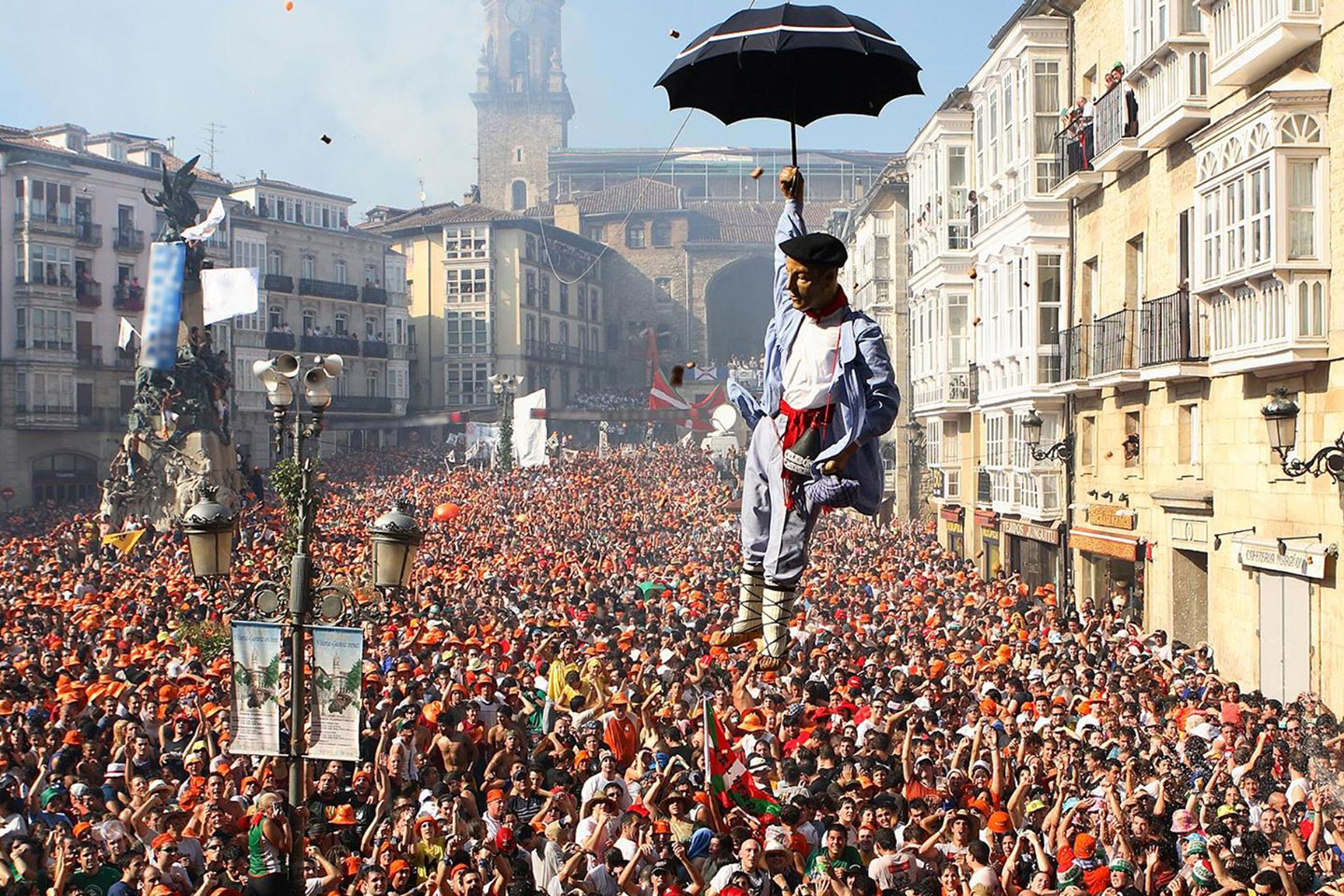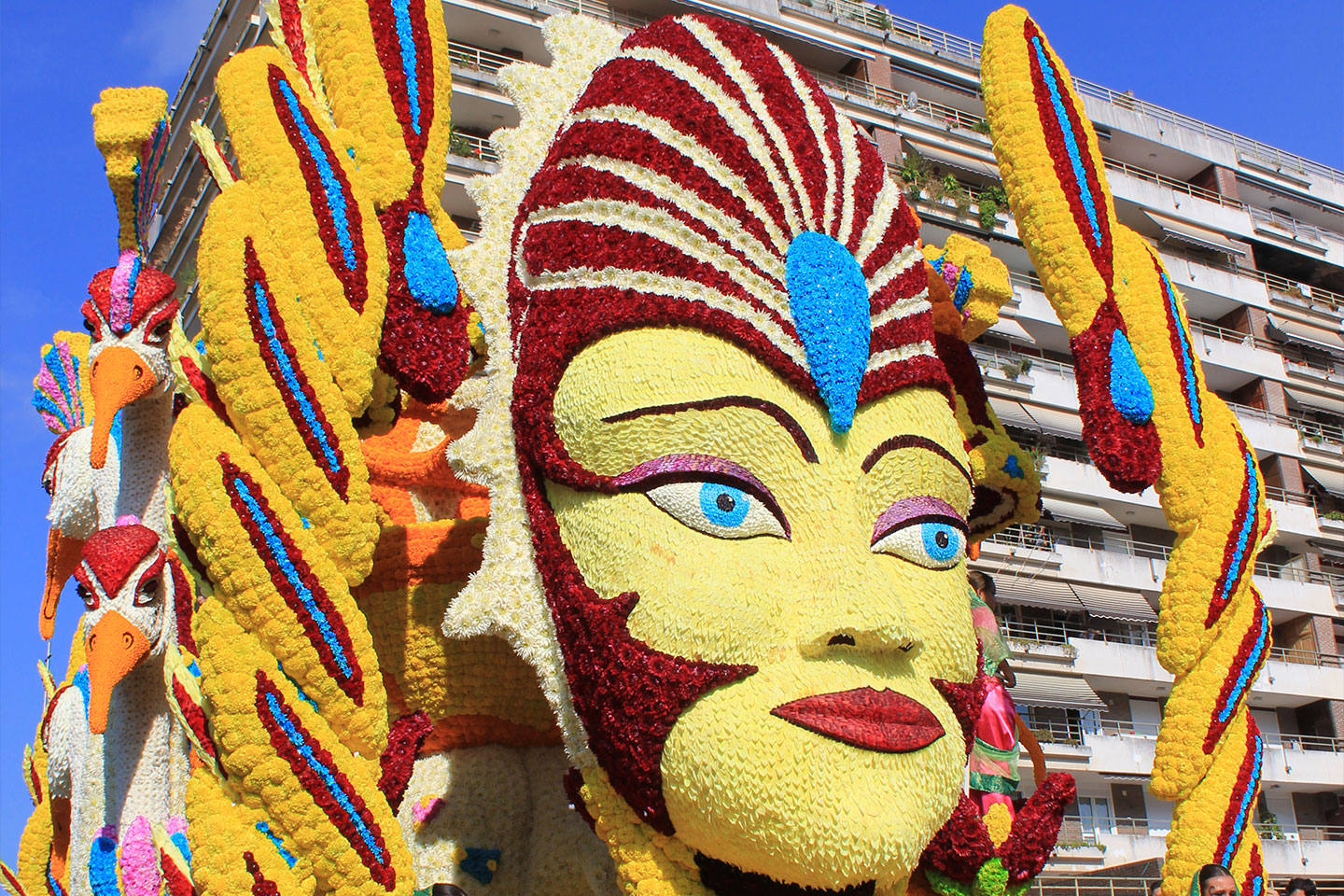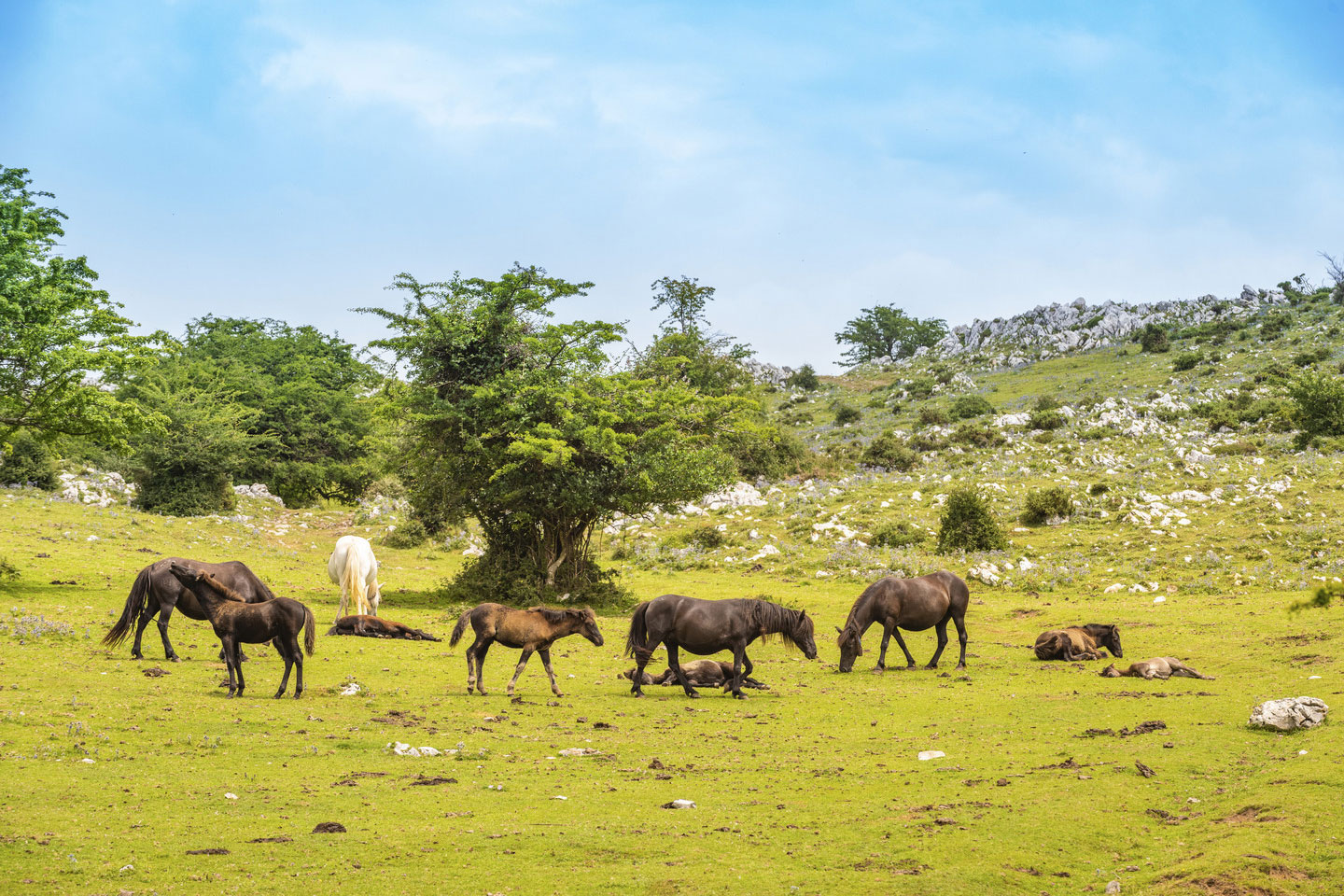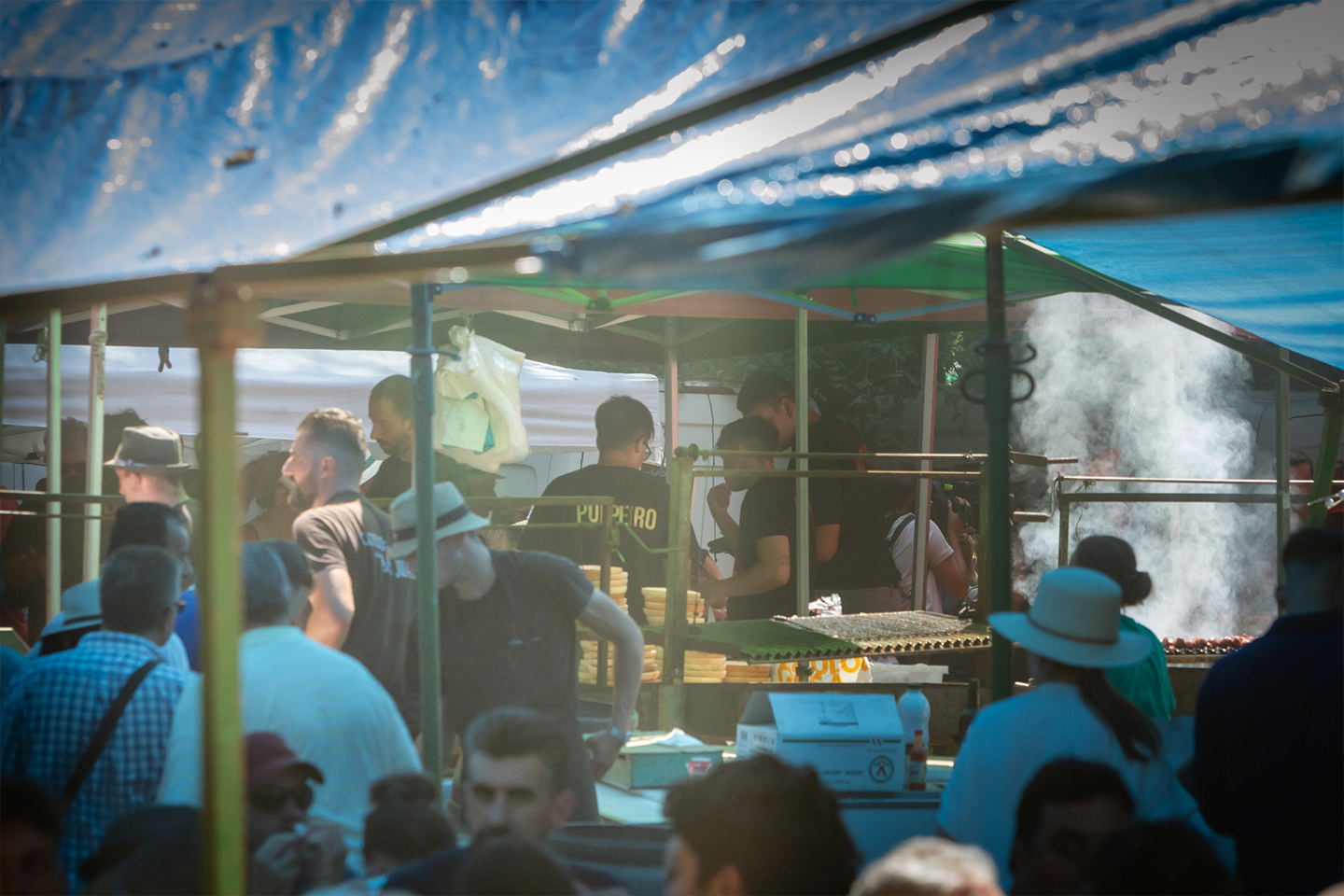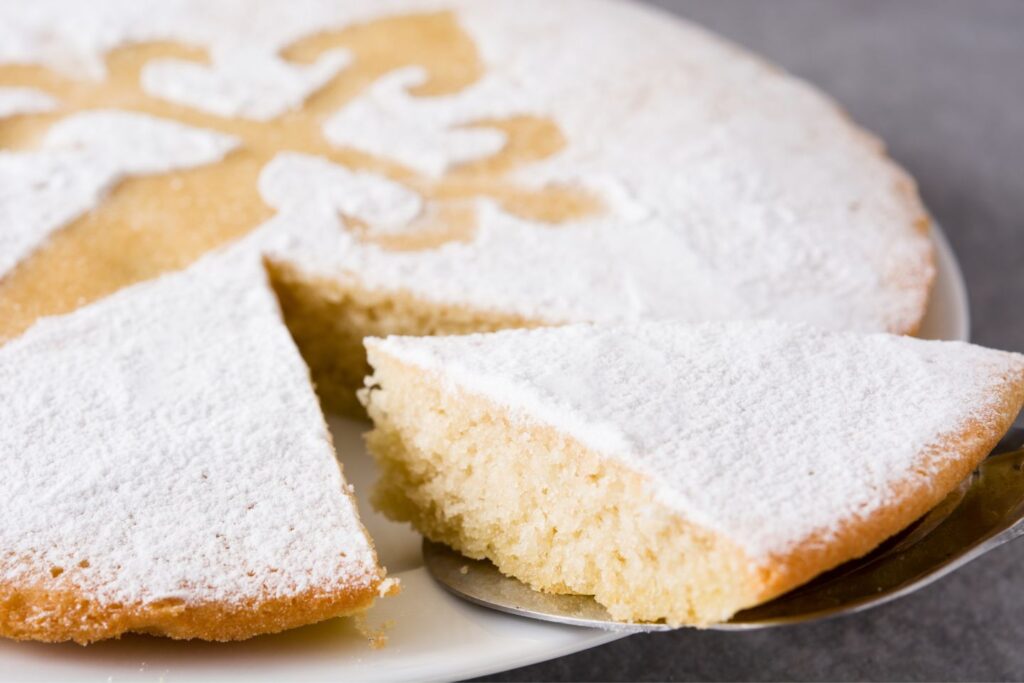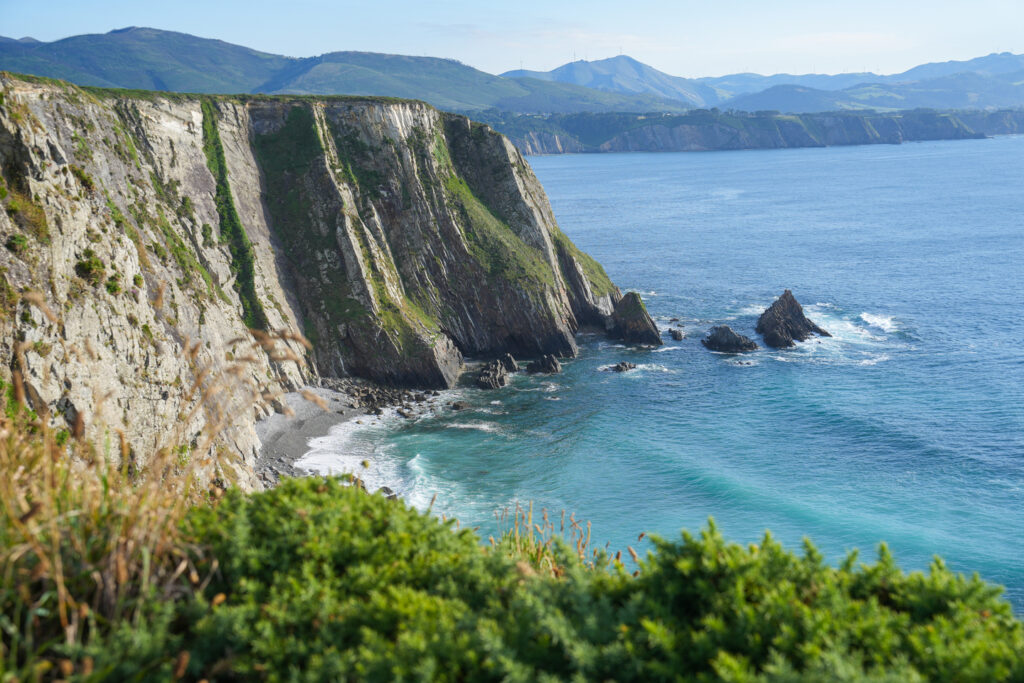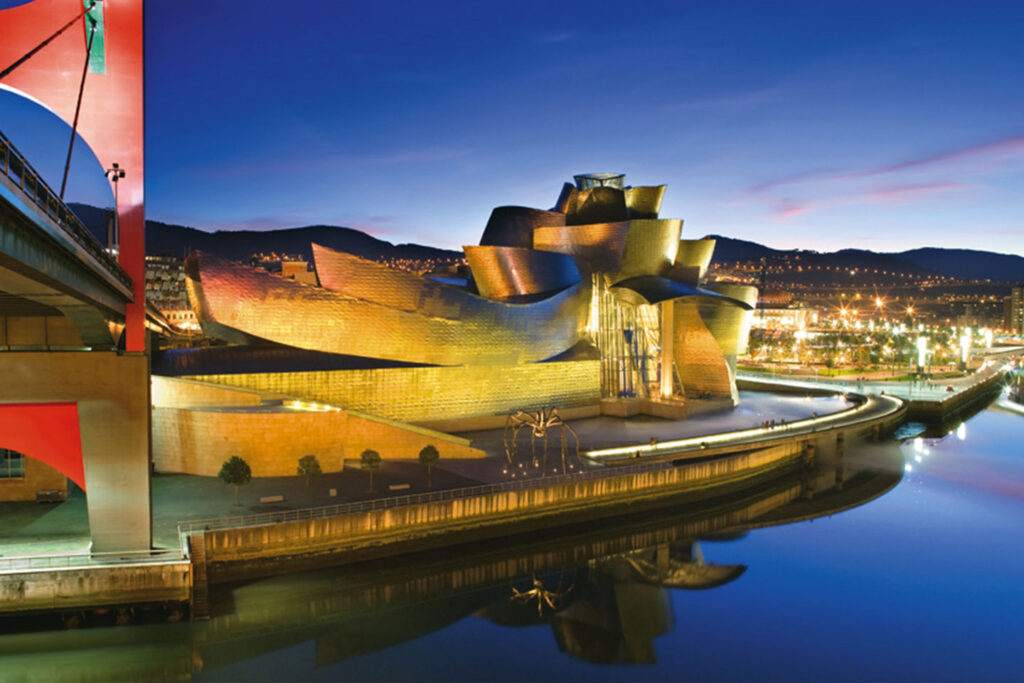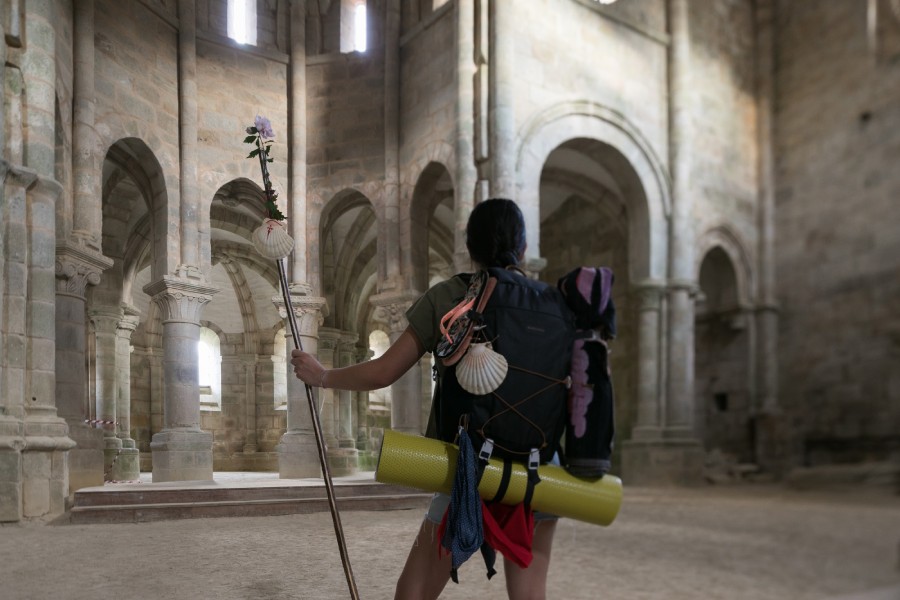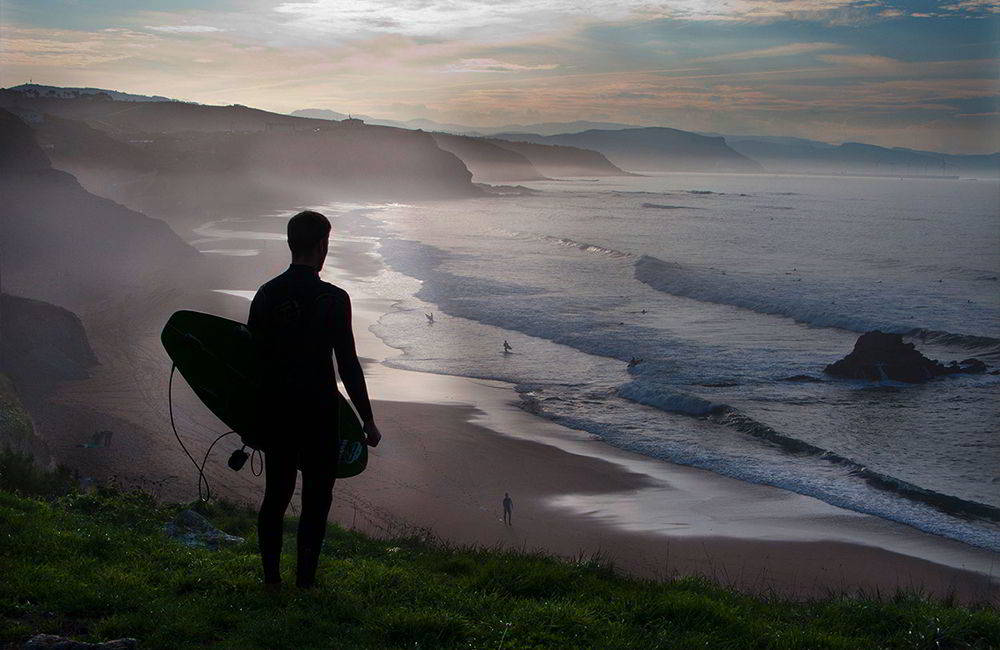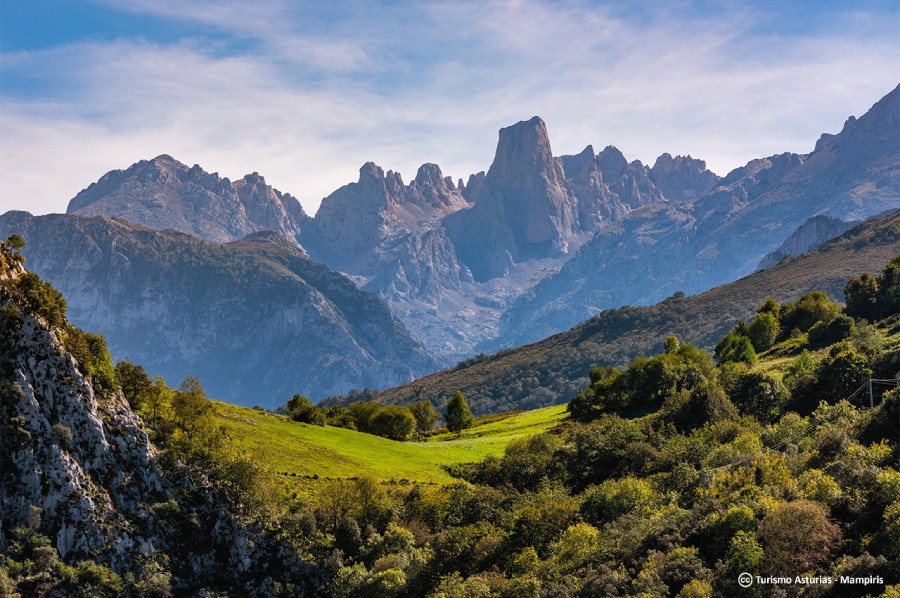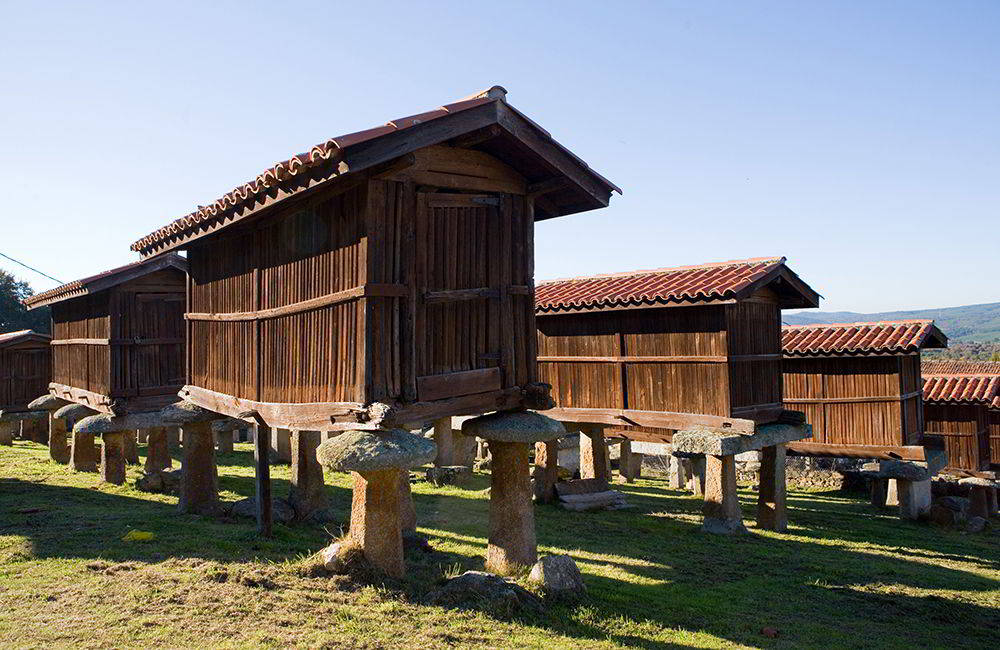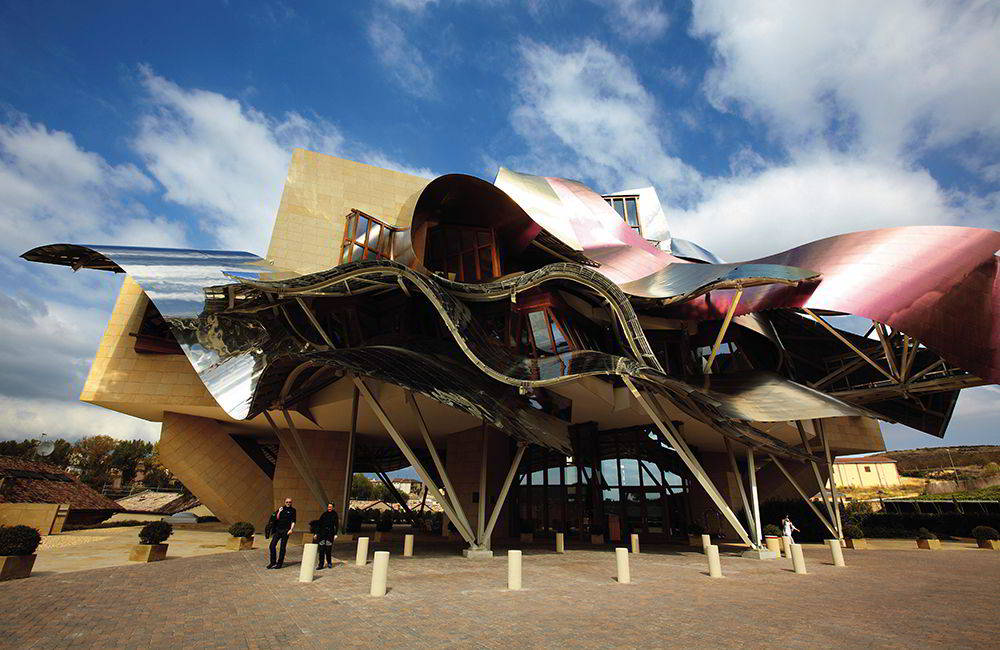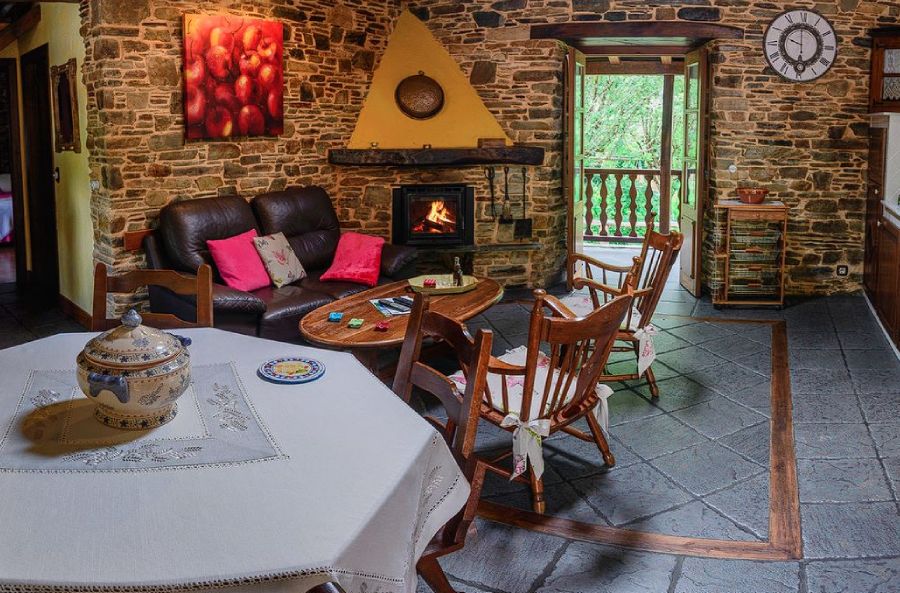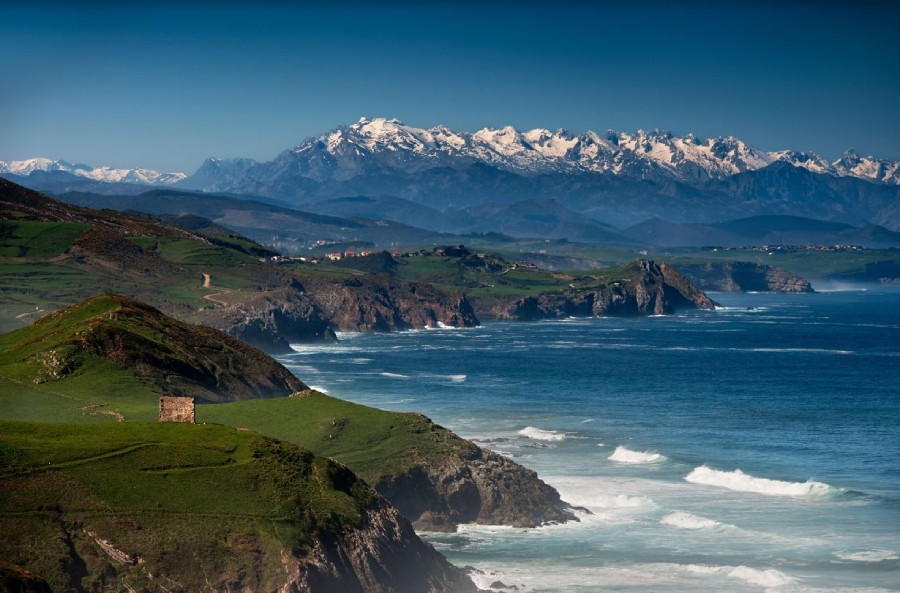Flower battles? Villagers flying with an umbrella? Strong muscled horses? Tons and tons of delicious “pulpo á feira” to be devoured in a festive atmosphere? If you don’t know how important festivals are in Green Spain, we’ve prepared a very brief introduction to this fascinating universe. You don’t need to bring anything: no food, no drinks. We’ll take care of everything (and make sure you have the best summer of your life).
Virgen Blanca Festivities, Vitoria-Gasteiz, Araba-Álava (Basque Country)
When are the Virgen Blanca Festivities in Vitoria-Gasteiz held?
The festivities officially begin on August 4 at noon with the descent of Celedón and end on August 9 at night. During those six days, Vitoria-Gasteiz becomes the festive capital of the Basque Country with all kinds of events, including concerts, theatrical programming, gastronomic and craft fairs, popular activities, events for children, and a curious traditional clog (“abarka” in Basque) throwing contest.
What’s the story behind the Virgen Blanca Festivities in Vitoria-Gasteiz?
Devotion to the Virgen Blanca dates back to the 14th century, but the festivities, as they are known today, began in the late 19th century to liven up the summer calendar. The figure of Celedón, perhaps the most universal icon of the festival, was introduced in 1957 to symbolize the arrival of the villagers to the city.
What experience of the Virgen Blanca Festivities should I not miss?
The most iconic moment is the descent of Celedón from the San Miguel tower. Thousands of people pack the Plaza de la Virgen Blanca to officially open the festivities with music, waving scarves, and (a lot of) spilled wine.
What can you eat during the Virgen Blanca Festivities?
Alongside the usual festive food (talos with txistorra and/or bacon at street stalls), the city’s pintxo offering stands out, especially around the Virgen Blanca square and nearby streets in both the medieval quarter and the modern expansion area.
What monument in Vitoria-Gasteiz must I absolutely visit?
Its medieval cathedral, Santa María, is a ‘must’ for anyone visiting the city for the first time. It’s a large Gothic temple, the main one in the Basque Country, that two decades ago turned necessity into virtue: during urgent restoration works (its medieval foundations were sinking), the cathedral opened to the public during the process, resulting in such a public success that even bestselling author Ken Follett found inspiration (and information) here for the second part of his popular “The Pillars of the Earth.” A statue of the author next to the cathedral commemorates this connection.
Battle of the Flowers, Laredo (Cantabria)
When is the Battle of the Flowers in Laredo held?
It takes place on the last Friday of August, which is the 29th in 2025. On that day, Laredo becomes a circuit hosting a spectacular parade of floats covered with hundreds of thousands of natural flowers, prepared for months by local residents. Words cannot do justice to the splendor of this festival: the display of imagination and resources is truly unique.
What’s the story behind the Battle of the Flowers in Laredo?
The first edition was held in 1908 as another summer celebration promoted by the local bourgeoisie to say farewell to summer (and the summer visitors, mainly from Madrid) with an event matching the elegance and good taste of the Belle Époque Laredo. In that first “battle,” it wasn’t floats but the fishermen’s traineras that were decorated.
What experience of the Battle of the Flowers in Laredo should I not miss?
The float parade through the downtown circuit held at sunset. Year after year, the creations evolve and become more and more extravagant, reaching up to eight meters high. Add to that the musical atmosphere and a whole town devoted to this event, which is declared a Festival of National Tourist Interest.
What can you eat during the Battle of the Flowers in Laredo?
The festival is a perfect opportunity to taste the delicacies of the Cantabrian coast such as anchovies (fresh in summer or salted year-round), bonito stew (also in summer), and a full array of fish and seafood; or garden products like “respigos” with your preferred accompaniment (shrimp, ham, or chorizo). In Laredo, it’s also common to “go out for wines” or have an aperitif, which guarantees a good selection of pinchos.
What monument in Laredo must I absolutely visit?
The Puebla Vieja, the medieval core of the town, with its cobbled streets, noble houses, and the church of Santa María de la Asunción, which houses a unique treasure in Cantabria and Spain: the Bethlehem altarpiece, a gem filled with Gothic sculptures. Incidentally, these are the very streets Emperor Charles V walked when, after leaving Flanders, he arrived in Spain to retire from public life in the 16th century. The event is commemorated with a major reenactment in September.
Asturcón Festival, Majada de Espineres, Piloña Council (Asturias)
When is the Asturcón Festival held in the Majada de Espineres?
Every summer, for almost 40 years, at the end of August. In 2025, it will be on the 24th. On this day, declared a Festival of National Tourist Interest, breeders, locals, and visitors gather in the mountains to honor this native equine breed, which was already mentioned (and described) by the military man and writer Pliny the Elder in the first century of our era! Despite their adorable appearance (Asturcón horses are known as “Asturian ponies”), the Romans did not spare them from the hardest tasks: they were commonly used in narrow mine galleries to extract large amounts of ore.
What’s the story behind the Asturcón Festival?
The Asturcón is a horse breed that lives freely in the Sueve mountain range and is known for its small size, thick hair, and muscular body. Mechanization and the increasing use of motor vehicles led these animals, primarily used for pulling loads, to fall into disuse, bringing them close to extinction. The festival was created to raise awareness of their story and celebrate their preservation by local breeders.
What experience of the Asturcón Festival should I not miss?
Just reaching an idyllic Asturian mountain pasture in the middle of the range and seeing the animals in their natural habitat is already a top-tier experience. One of the most exciting moments is the branding and taming show, where foals born in the wild are guided by breeders in a demonstration of skill and connection with the animals. The celebration includes an open-air mass, an award ceremony, all immersed in traditional music and a festive atmosphere.
What can you eat during the Asturcón Festival?
The day includes a picnic-style meal in the open air, where you can taste typical Asturian products like artisan cheeses, empanadas, local cold meats, and natural cider.
What monument or place in the area must I absolutely visit?
It would be unfair to refer to the Sueve Range as just a monument because it is much more than that. In fact, it features a unique phenomenon on the northern coast: the Pienzu peak, which at 1,161 meters above sea level is the highest coastal mountain in Europe. Of course, there are taller peaks, but none so close to the Cantabrian Sea (or any other European sea). The best starting point to explore the range is the Sueve Range Interpretation Center located in Colunga. From there, guided tours are organized in the mornings and afternoons to discover the peak and other key ecosystems like the Biescona beech forest.
Festa do Pulpo in O Carballiño, Ourense (Galicia)
When is the Festa do Pulpo held in O Carballiño?
It is held on the second Sunday of August; in 2025, it will take place on the 10th. On that day, more than 25,000 kilos of octopus are prepared, accompanied by other Galician delicacies such as Cea bread, empanada, and of course, Ribeiro wine.
What’s the story behind the Festa do Pulpo in O Carballiño?
It began in 1964 as a way to promote “pulpo á feira” and boost local tourism. Since then, the festival and the popularity of this dish made with octopus, potatoes, olive oil, and paprika have grown to the point of being declared a Festival of International Tourist Interest. In the 21st century, octopus with potatoes is surely one of the top 10 iconic dishes of Spanish cuisine, alongside paella and tortilla de patatas.
What experience of the Festa do Pulpo should I not miss?
In case there was any doubt, the supreme experience is heading to the Municipal Park to take part in the communal feast, as if it were a grand village celebration like those of the past throughout Spain, and eating “pulpo á feira” in the park. As simple and majestic as that.
What can you eat during the Festa do Pulpo?
The main dish is “pulpo á feira” with olive oil, salt, and paprika, boiled in copper pots, cut with scissors over wooden plates. There’s also empanada, Cea bread, and Ribeiro wine served in the traditional “cunca.”
What monument or place in O Carballiño must I absolutely visit?
Although it’s impossible to miss, it’s worth highlighting the grandeur of the Vera Cruz church, a unique and utterly eclectic work (with neo-Gothic elements, features reminiscent of a medieval castle, a bell tower that could belong to a Gaudí-style modernist building, corners evoking a cloister, walls that could be part of a Galician manor house…) built in the mid-20th century by architect Antonio Palacios. The distinctive color of its stone is a nod to the local quarries from which all the raw materials were sourced.
